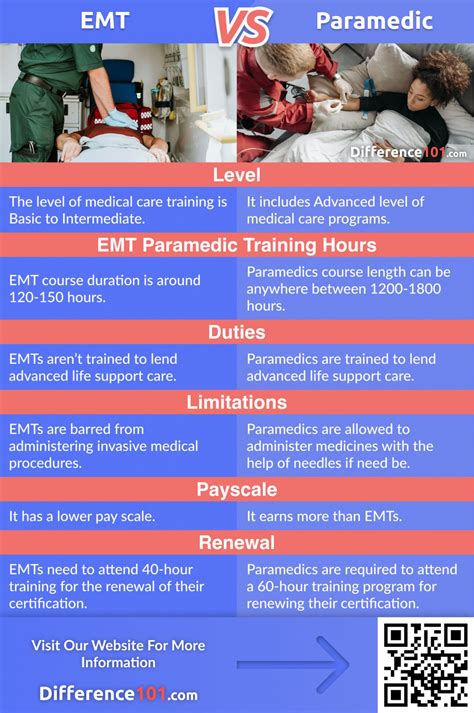Introduction

The healthcare industry offers a wide spectrum of career paths, each with its unique set of responsibilities and educational requirements. Two prominent paths are those of paramedics and medical doctors. While both professions share a common goal of providing patient care, their approaches and educational journeys differ significantly.
Paramedic Training
Paramedics play a vital role in the prehospital setting, providing emergency medical care to patients in critical situations. They undergo rigorous training to develop advanced medical skills and knowledge, including:
- Patient assessment and management
- Trauma care
- Cardiac emergencies
- Advanced life support techniques
- Medication administration
Paramedic training typically takes place at community colleges or technical institutes and can be completed in two to three years. Upon completion, paramedics must pass a national certification exam.
Medical School
Medical doctors, on the other hand, receive comprehensive training in all aspects of human health and disease. They attend medical school for four years, followed by a three to seven-year residency program specializing in a particular medical field.
Medical school curriculum includes:
- Anatomy and physiology
- Biochemistry
- Microbiology
- Pharmacology
- Clinical rotations in various medical disciplines
After completing their residency, physicians must pass a series of board examinations to obtain their medical license.
Similarities and Differences
Both paramedics and medical doctors provide critical care to patients. However, there are several key differences between the two professions:
| Feature | Paramedic | Medical Doctor |
|---|---|---|
| Education | Associate’s degree | Medical degree |
| Training | Two to three years | Four years of medical school, three to seven years of residency |
| Certification | National certification exam | Board certification in a medical specialty |
| Scope of Practice | Prehospital emergency care | Comprehensive medical care |
| Patient Interaction | Focus on immediate stabilization and transport | In-depth assessment, diagnosis, and treatment plans |
Career Considerations
The choice between becoming a paramedic and a medical doctor depends on an individual’s career goals, interests, and abilities.
Paramedics typically work in fire departments or emergency medical services agencies, responding to emergency calls and providing immediate patient care. They often work in high-stress environments and must be able to make quick decisions under pressure.
Medical doctors work in a variety of settings, including hospitals, clinics, and private practices. They provide primary and specialty care to patients, ranging from routine check-ups to complex medical procedures. They must have a strong foundation in medical knowledge and possess excellent communication and interpersonal skills.
Income and Job Outlook
According to the Bureau of Labor Statistics (BLS), the median annual salary for paramedics in May 2021 was $36,650. The BLS projects a 7% growth in paramedic jobs from 2021 to 2031.
Medical doctors earn significantly higher salaries, with the median annual salary for all physicians and surgeons in May 2021 being $208,000. The BLS projects a 3% growth in physician and surgeon jobs from 2021 to 2031.
Educational Expenses
The cost of education for paramedics and medical doctors varies significantly. Paramedic training typically costs around $10,000 to $30,000, while medical school tuition and fees can exceed $200,000.
Continuing Education
Both paramedics and medical doctors must complete continuing education courses to maintain their certifications and licenses. Paramedics typically earn continuing education credits through conferences, workshops, and online courses. Medical doctors must complete continuing medical education (CME) credits through accredited programs.
Pain Points and Motivations
Paramedics
- Pain Points:
- High-stress work environment
- Limited career advancement opportunities
- Potential for burnout
- Motivations:
- Desire to help others in emergency situations
- Ability to make a difference in patients’ lives
- Commitment to providing prehospital care
Medical Doctors
- Pain Points:
- Long and demanding training process
- High levels of student debt
- Potential for burnout
- Motivations:
- Passion for medicine and patient care
- Desire to diagnose and treat complex diseases
- Commitment to improving patient outcomes
Conclusion
Paramedics and medical doctors play essential roles in the healthcare system, providing critical care to patients in different settings. The choice between these two professions depends on an individual’s passions, abilities, and career goals. While paramedics focus on immediate stabilization and transport, medical doctors provide comprehensive medical care and treatment plans. Both professions offer fulfilling and rewarding careers in the healthcare field.
Table 1: Education and Training
| Profession | Education | Training |
|---|---|---|
| Paramedic | Associate’s degree | Two to three years |
| Medical Doctor | Medical degree | Four years of medical school, three to seven years of residency |
Table 2: Scope of Practice
| Profession | Scope of Practice |
|---|---|
| Paramedic | Prehospital emergency care |
| Medical Doctor | Comprehensive medical care |
Table 3: Income and Job Outlook
| Profession | Median Annual Salary (May 2021) | Projected Job Growth 2021-2031 |
|---|---|---|
| Paramedic | $36,650 | 7% |
| Medical Doctor | $208,000 | 3% |
Table 4: Educational Expenses
| Profession | Approximate Cost |
|---|---|
| Paramedic | $10,000 to $30,000 |
| Medical Doctor | $200,000+ |
